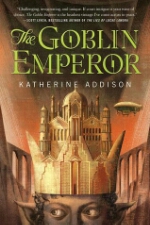Yesterday, I wrote about the fantastic Goblin Emperor, the latest book from Sarah Monette under the nom de plume Katherine Addison; as you’ll have gathered, I absolutely adored the book. However, it struck me how very different the world of the novel was from any of her other work that I have read – the Iskryne books coauthored with Elizabeth Bear, her previous fantasy series The Doctrine of Labyrinths, or her linked series of Lovecraftian homages, the Booth stories. So I asked her how she built such very different worlds… and she very kindly agreed to write about exactly that for me! Below, the fantastic Sarah Monette, with a fascinating essay on Worldbuilding!
~~~~~
I world-build like a magpie. Or a bower bird. Find a shiny thing, take it back, incorporate it into the nest. Look for shiny things everywhere.
In the Doctrine of Labyrinths books, I didn’t do much camouflaging, throwing in the Napoleonic revolutionary calendar unchanged and stealing the names of mythical female monsters and lost Shakespeare plays. I was in graduate school for most of the writing of the quartet, and I threw in bits and pieces from all of my classes: the town of Yehergod got its name because I was taking an Old English class. Cerberus Cresset got his name from an English Civil War memoir, in which Lucy Hutchinson bitterly describes her imprisoned husband’s guard as “that Cerberus, Cresset.” The theater sub-plot in The Mirador was a chance to use what I learned from my theater history class about Renaissance and Restoration and Victorian theater. All the Greek and Latin comes from my undergraduate major in Classics. The bog bodies in Corambis are lifted from P. V. Glob’s book The Bog People. Districts of Melusine get their names from Babylonian epics and Spenser’s Fairie Queene and words that I found and loved the sound of when I combined them, like Shatterglass. I could go on indefinitely, but my point is that I was world-building purely for the love of language and esoterica and geeky in-jokes in the Doctrine books, and if that’s self-indulgent, well . . . I’m not sorry.
Kyle Murchison Booth’s world is rather different, since it’s only a fraction off from ours. The world itself is a pastiche/collage of H. P. Lovecraft and M. R. James, and the world-building primarily takes place through texts, like Wells-Burton’s Demonologica in “Elegy for a Demon Lover,” the works of Carolus Albinus in “White Charles,” and The Book of Whispers, both the genuine (in “The Inheritance of Barnabas Wilcox”) and the forgery (in a novella I’m still working on). One of the reasons I love writing Booth stories is that they let me make up books and authors and bits of literary history, and because books are the way Booth interacts with the world, the world-building is always a reaffirmation of character.
World-building in The Goblin Emperor was rather different because–obviously–I’d cut myself off from all my usual strategies. That wasn’t by design, but I don’t think it was a bad thing. I still world-build through words. Maia, Setheris, Edonomee, The Wisdom of Choharo: I built the world in a spiral out from those words and what those words told me about characters and places. And airships.
I can’t explain how words bring character and place and history with them, how Edonomee was a hunting lodge in the marshes, shabby and isolated, as soon as I’d figured out how to spell it, or Ezho was always a gold rush town (even though we never see it), rich and brawling and brash and young. It’s just how my creativity works, and I don’t get to argue with it any more than I get to understand it.
But the process of world-building is actually easy to explain, because the process is just thinking through the consequences. Every choice you make in building a world leads to other choices. If you have an emperor, he must have a government. How does that government work? If there’s a parliament, how are the members chosen? How much does the emperor actually get to do? He must have a palace. Who built it? When? Is it only the emperor’s residence, or is it also the seat of government? Same goes for geography. Is point A (Edonomee) east or west of point B (the Untheileneise Court)? How far? There’s a river in the way. What’s its name? Is there traffic on it? Are there bridges?
Come to find out, there aren’t bridges, and that turned out to be not just world-building, but an enormous part of the story.
Some writers have to make all those choices before they can start writing. Some prefer to. It’s never worked for me, because part of what makes me write is the part where I get to discover things. E. L. Doctorow describes writing as being like “driving a car at night. You never see further than your headlights, but you can make the whole trip that way,” and that’s pretty accurate as far as I’m concerned. I world-build (and character-build and plot-build) as I go, only looking far enough ahead, generally, to see the next obstacle.
It hasn’t stopped being fun yet, either.


[…] Monette, aka Katherine Addison, talks about worldbuilding and The Goblin Emperor at Dan Franklin’s […]
[…] Intellectus Speculativus (formerly Daniel Libris) post on worldbuilding […]
[…] Intellectus Speculativus (formerly Daniel Libris) post on worldbuilding […]
[…] publishing essays by luminaries in the field, including Kameron Hurley (twice!), Stephanie Saulter, Katherine Addison/Sarah Monette and Liz Bourke. I’m satisfied with the variety I covered […]